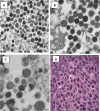Marrow cell genetic phenotype change induced by human lung cancer cells
- PMID: 21864488
- PMCID: PMC4568832
- DOI: 10.1016/j.exphem.2011.08.008
Marrow cell genetic phenotype change induced by human lung cancer cells
Abstract
Microvesicles have been shown to mediate varieties of intercellular communication. Work in murine species has shown that lung-derived microvesicles can deliver mRNA, transcription factors, and microRNA to marrow cells and alter their phenotype. The present studies evaluated the capacity of excised human lung cancer cells to change the genetic phenotype of human marrow cells. We present the first studies on microvesicle production by excised cancers from human lung and the capacity of these microvesicles to alter the genetic phenotype of normal human marrow cells. We studied 12 cancers involving the lung and assessed nine lung-specific mRNA species (aquaporin, surfactant families, and clara cell-specific protein) in marrow cells exposed to tissue in co-culture, cultured in conditioned media, or exposed to isolated lung cancer-derived microvesicles. We assessed two or seven days of co-culture and marrow which was unseparated, separated by ficoll density gradient centrifugation or ammonium chloride lysis. Under these varying conditions, each cancer derived from lung mediated marrow expression of between one and seven lung-specific genes. Microvesicles were identified in the pellet of ultracentrifuged conditioned media and shown to enter marrow cells and induce lung-specific mRNA expression in marrow. A lung melanoma and a sarcoma also induced lung-specific mRNA in marrow cells. These data indicate that lung cancer cells may alter the genetic phenotype of normal cells and suggest that such perturbations might play a role in tumor progression, tumor recurrence, or metastases. They also suggest that the tissue environment may alter cancer cell gene expression.
Copyright © 2011. Published by Elsevier Inc.
Figures





Similar articles
-
Microvesicle entry into marrow cells mediates tissue-specific changes in mRNA by direct delivery of mRNA and induction of transcription.Exp Hematol. 2010 Mar;38(3):233-45. doi: 10.1016/j.exphem.2010.01.002. Epub 2010 Jan 15. Exp Hematol. 2010. PMID: 20079801 Free PMC article.
-
Stable cell fate changes in marrow cells induced by lung-derived microvesicles.J Extracell Vesicles. 2012 Apr 16;1. doi: 10.3402/jev.v1i0.18163. eCollection 2012. J Extracell Vesicles. 2012. PMID: 24009878 Free PMC article.
-
Progenitor/stem cell fate determination: interactive dynamics of cell cycle and microvesicles.Stem Cells Dev. 2012 Jul 1;21(10):1627-38. doi: 10.1089/scd.2011.0550. Epub 2012 Feb 15. Stem Cells Dev. 2012. PMID: 22214238 Free PMC article.
-
The paradoxical dynamism of marrow stem cells: considerations of stem cells, niches, and microvesicles.Stem Cell Rev. 2008 Sep;4(3):137-47. doi: 10.1007/s12015-008-9036-y. Epub 2008 Jul 30. Stem Cell Rev. 2008. PMID: 18665337 Free PMC article. Review.
-
The stem cell continuum: cell cycle, injury, and phenotype lability.Ann N Y Acad Sci. 2007 Jun;1106:20-9. doi: 10.1196/annals.1392.016. Epub 2007 Mar 14. Ann N Y Acad Sci. 2007. PMID: 17360803 Review.
Cited by
-
Cellular phenotype and extracellular vesicles: basic and clinical considerations.Stem Cells Dev. 2014 Jul 1;23(13):1429-36. doi: 10.1089/scd.2013.0594. Epub 2014 Apr 1. Stem Cells Dev. 2014. PMID: 24564699 Free PMC article.
-
Cell cycle time series gene expression data encoded as cyclic attractors in Hopfield systems.PLoS Comput Biol. 2017 Nov 17;13(11):e1005849. doi: 10.1371/journal.pcbi.1005849. eCollection 2017 Nov. PLoS Comput Biol. 2017. PMID: 29149186 Free PMC article.
-
Concise review: stem/progenitor cells for renal tissue repair: current knowledge and perspectives.Stem Cells Transl Med. 2013 Dec;2(12):1011-9. doi: 10.5966/sctm.2013-0097. Epub 2013 Oct 28. Stem Cells Transl Med. 2013. PMID: 24167320 Free PMC article. Review.
-
The role of extracellular vesicles in the progression of neurodegenerative disease and cancer.Trends Mol Med. 2014 Jul;20(7):368-74. doi: 10.1016/j.molmed.2014.04.003. Epub 2014 May 14. Trends Mol Med. 2014. PMID: 24835084 Free PMC article. Review.
-
Extracellular vesicles as an emerging mechanism of cell-to-cell communication.Endocrine. 2013 Aug;44(1):11-9. doi: 10.1007/s12020-012-9839-0. Epub 2012 Dec 1. Endocrine. 2013. PMID: 23203002 Free PMC article. Review.
References
-
- Morel O, Toti F, Hugel B, Freyssinet JM. Cellular microparticles: a disseminated storage pool of bioactive vascular effectors. Curr Opin Hematol. 2004;11:156–164. - PubMed
-
- Janowska-Wieczorek A, Majka M, Kijowski J, et al. Platelet-derived microparticles bind to hematopoietic stem/progenitor cells and enhance their engraftment. Blood. 2001;98:3143–3149. - PubMed
-
- Baj-Krzyworzeka M, Majka M, Pratico D, et al. Platelet-derived microparticles stimulate proliferation, survival, adhesion, and chemotaxis of hematopoietic cells. Exp Hematol. 2002;30:450–459. - PubMed
-
- Rozmyslowicz T. Platelet- and megakaryocyte-derived microparticles transfer CXCR4 receptor to CXCR4-null cells and make them susceptible to infection by X4-HIV. AIDS. 2003;17:33–42. - PubMed
-
- Graves LE, Ariztia EV, Navari JR, Matzel HJ, Stack MS, Fishman DA. Proinvasive properties of ovarian cancer ascites-derived membrane vesicles. Cancer Res. 2004;64:7045–7049. - PubMed
Publication types
MeSH terms
Substances
Grants and funding
LinkOut - more resources
Full Text Sources
Medical

